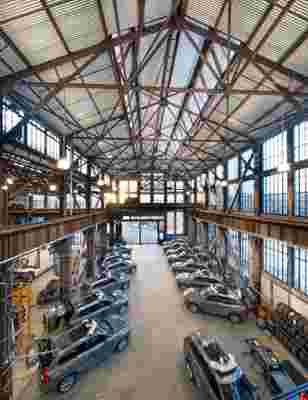It’s true that real estate in downtown San Francisco is limited—very limited. But that didn’t stop Uber from seeking out a massive space in the city to house its Advanced Technologies Group, the branch of the company responsible for its experimental, forward-thinking projects, like self-driving cars, flying vehicles (Uber Elevate), the LiDAR laboratory, and JUMP bikes and scooters. The answer was simple—lease part of Pier 70, the largest intact industrial complex west of the Mississippi, located in the Dogpatch neighborhood of San Francisco. Built during the late 19th century (the oldest building was erected in 1885), Pier 70 is currently being developed into a multi-use complex comprising offices, shopping, green space, and residential units along the San Francisco Bay (SF-based urban studio SITELAB is the masterplanner for the large development).
“The space was once home to Bethlehem Shipbuilding, and we loved the idea of having our Advanced Technologies Group extend the site’s transportation legacy,” says Aaron Doubt, director of Advanced Technologies Group Facilities at Uber. “And we needed a large space that could bear the weight of multiple cars and trucks, and that had vast room for our teams to build.” So the company leased out 130,000 square feet of space spanning two city blocks within the complex. The only problem was, until this past year, Pier 70 was pretty much in ruins.

The new offices kept much of the old charm while maintaining a futuristic aesthetic throughout the space.
“We saw significant decay,” says Doubt. “In fact, there was only half a roof, there were walls with no windows, and the floor was essentially dirt.” While the complex was thriving during its days as Bethlehem Shipbuilding—and prior to that as Union Iron Works and Bethlehem Steel—it was completely abandoned over the past several decades, leaving it vulnerable not only to the elements but also to vandalism.

A look at the interiors of the space, which were almost entirely gutted to make way for Uber's renovation project.
“The conditions of the buildings were beyond decrepit, and the unreinforced masonry of Building 113 that was exposed to water was deteriorated to the point of crumbling to powder,” adds Marcy Wong of the architecture firm Mary Wong Donn Logan, which Uber tasked with revitalizing the site. “The walls were on the verge of total collapse.”

An aerial view of cars located with Uber's new office. The space will advance new technologies, such as self-driving cars.
And so began extensive renovation work. Given that the buildings are more than 100 years old, they were originally nowhere near up to today’s earthquake codes, a problem the architects had to address immediately. During construction, temporary shelters had to be installed on site to protect the workers in the event of an earthquake. To stabilize the structure more permanently, steel braces and columns were strategically placed to blend in with the original architecture as best as possible. Given that Pier 70 belongs in the Union Iron Works Historic District, which is listed on the National Register of Historic Places, there are strict rules about preserving original elements of the buildings. “Fortunately, the old buildings are blessed with great architectural bones, magnificent potential natural light from skylights and windows, plus iconic craneways in dramatic volumes that allowed the insertion of mezzanines, bridges, and stairs,” says Wong.
The new space still has hallmarks of the buildings previous life as a shipbuilding complex.
Those architectural features divide up the cavernous spaces in the structure so that there are almost buildings within buildings, providing meeting rooms, private offices, lounge spaces, and even a cafeteria—not to mention workshop areas to house vehicles and prototypes. “We took extreme care to keep the look and feel of the original composition from the early 1900s while bringing it up to code with our standards for a safe, comfortable workspace,” says Doubt. “It was a labor of love, that’s for sure.”

Leave a Reply